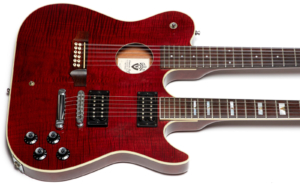 You say you like rare Guilds? Well this is your lucky day because today’s review is of a rare Guild Crossroads Doubleneck guitar.
You say you like rare Guilds? Well this is your lucky day because today’s review is of a rare Guild Crossroads Doubleneck guitar.
Designed by Slash of Guns ‘n Roses fame (not to mention Slash’s Snake Pit, Velvet Revolver, and his current collaboration with Myles Kennedy), this guitar is a very unique design that solves a problem that few other guitars can. You see, this instrument is not only a six-string and a 12-string guitar, but the 12-string is an actual acoustic guitar!
This is a big guitar with twice the uh… guitar… of a normal guitar, so this is a big review with almost twice the words of a typical review. That means you should buckle up, crank some Anastasia, and discover what it’s like to own a real Guild Crossroads doubleneck guitar.
Introduction
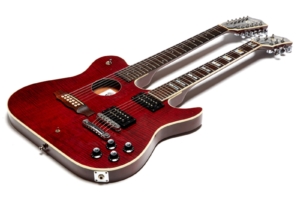 There are few more iconic images in Rock ‘n Roll history than Jimmy Page in the early ’70s playing a Gibson doubleneck guitar. Seeing him play that EDS-1275 guitar made a legion of young players (myself included) lust after the distinctive dual SG monster, but back in the ’70s and ’80s few of us ever actually saw one in person let alone bought one. They were relatively uncommon, they were expensive, and word on the street was that they weighed a cool 13 pounds (5.9 kg) or more, but we all still wanted one of those enormous slabs of mahogany with two necks. Why? Because there’s something about welding a doubleneck on stage that makes you look and feel like a god.
There are few more iconic images in Rock ‘n Roll history than Jimmy Page in the early ’70s playing a Gibson doubleneck guitar. Seeing him play that EDS-1275 guitar made a legion of young players (myself included) lust after the distinctive dual SG monster, but back in the ’70s and ’80s few of us ever actually saw one in person let alone bought one. They were relatively uncommon, they were expensive, and word on the street was that they weighed a cool 13 pounds (5.9 kg) or more, but we all still wanted one of those enormous slabs of mahogany with two necks. Why? Because there’s something about welding a doubleneck on stage that makes you look and feel like a god.
 Certainly one could question if the god we wanted to look like was Jimmy Page, in no small part because an entire generation saw him in The Song Remains the Same wielding the famous doubleneck SG, but I personally think there’s something more to it than that. I think the average person is impressed by the dual-necked beast because everyone knows that playing the guitar takes dedication and perseverance, so only a true master would dare play two at once, right? Sure, you can only play one at a time, but with so much guitar strapped to your body, you must certainly be a virtuoso.
Certainly one could question if the god we wanted to look like was Jimmy Page, in no small part because an entire generation saw him in The Song Remains the Same wielding the famous doubleneck SG, but I personally think there’s something more to it than that. I think the average person is impressed by the dual-necked beast because everyone knows that playing the guitar takes dedication and perseverance, so only a true master would dare play two at once, right? Sure, you can only play one at a time, but with so much guitar strapped to your body, you must certainly be a virtuoso.
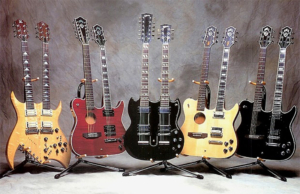 While Jimmy Page was “the one that played the doubleneck”, there have been many other players of note from Rick Nielson with his famous 5-neck monstrosity to Don Felder of The Eagles who used a white Gibson for the song Hotel California on stage. Another user of the doubleneck guitar is obviously Slash, perhaps best known as the guitarist for Guns ‘n Roses, but also for Velvet Revolver and now Slash featuring Myles Kennedy and The Conspirators. Though currently a brand ambassador for Gibson who is selling a pile of guitars with his name on them, in the late ’90s and early ’00s Slash worked with Guild to design the Crossroads doubleneck guitar being reviewed here.
While Jimmy Page was “the one that played the doubleneck”, there have been many other players of note from Rick Nielson with his famous 5-neck monstrosity to Don Felder of The Eagles who used a white Gibson for the song Hotel California on stage. Another user of the doubleneck guitar is obviously Slash, perhaps best known as the guitarist for Guns ‘n Roses, but also for Velvet Revolver and now Slash featuring Myles Kennedy and The Conspirators. Though currently a brand ambassador for Gibson who is selling a pile of guitars with his name on them, in the late ’90s and early ’00s Slash worked with Guild to design the Crossroads doubleneck guitar being reviewed here.
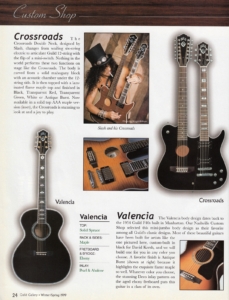 In my catalog collection, the Crossroads doubleneck first appears in the custom shop section of the 1997-1998 Guild Gallery magazine where Slash is shown playing one in the centerfold of the magazine. And yes, these magazines have centerfolds! In this catalog’s writeup of the Custom Shop, the original guitar built for Slash is described as the unique patented Crossroads™ doubleneck which was built in Westerly. I could not find a patent that matched the guitar, and since future catalogs never again mention the patent I’m not sure what, if anything, was patented.
In my catalog collection, the Crossroads doubleneck first appears in the custom shop section of the 1997-1998 Guild Gallery magazine where Slash is shown playing one in the centerfold of the magazine. And yes, these magazines have centerfolds! In this catalog’s writeup of the Custom Shop, the original guitar built for Slash is described as the unique patented Crossroads™ doubleneck which was built in Westerly. I could not find a patent that matched the guitar, and since future catalogs never again mention the patent I’m not sure what, if anything, was patented.
Edit Jan 3 2021: Thanks to user SFIV1967 (Ralf) who pointed me to the very next catalog page I posted in this review which shows the patent number, I’ve added the following paragraph:
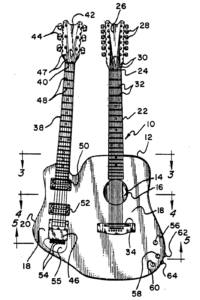 US Patent #4,987,815 by Gary Shockley of Atco NJ patented the combination electric and acoustic guitar which was granted on January 29th, 1991. That patent, which you can read in full here, includes this glorious but mildly unnerving illustration. Thankfully Guild and Slash took this idea and made a prettier guitar out of it, because that drawing looks like something from a David Cronenberg movie.
US Patent #4,987,815 by Gary Shockley of Atco NJ patented the combination electric and acoustic guitar which was granted on January 29th, 1991. That patent, which you can read in full here, includes this glorious but mildly unnerving illustration. Thankfully Guild and Slash took this idea and made a prettier guitar out of it, because that drawing looks like something from a David Cronenberg movie.
This catalog states that the neck and electronics of the 6-string side is from the Guild Bluesbird while the 12-string side is described as being chambered. That makes it built a bit differently than a traditional acoustic guitar, but then for the limited depth of the instrument theres not much room for traditional build techniques. The colors listed in this catalog are Black, Transparent Red, Transparent Green, White, or Antique Burst, and of course no Slash-designed guitar catalog page would be complete without a shirtless top-hat adorned Slash.
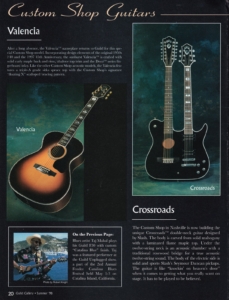 The Crossroads doubleneck guitar is shown briefly in the 1998 catalog in the Custom Shop section where it is mentioned that the Nashville Custom Shop is now building the guitar.
The Crossroads doubleneck guitar is shown briefly in the 1998 catalog in the Custom Shop section where it is mentioned that the Nashville Custom Shop is now building the guitar.
The Winter 1999 catalog says that the doubleneck is now available with a AAA top. Slash is in the later July-December 1999 catalog with a shirt looking almost respectable.
The 2000 catalog also has the Crossroads doubleneck and lists the pickups in the six-string side as Seymour Duncan Slash models and the Fishman Acoustic Matrix Natural with Custom Preamp on the 12-string side. There is no shirtless Slash pic in this catalog. The 2001 catalog shows the same picture, has the same ad copy, and also is devoid of shirtless Slash pictures, much to the detriment of us all.
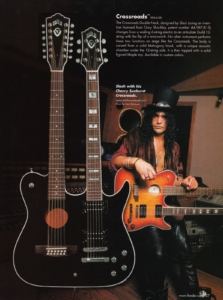 The 2002 Guild catalog is the last one in my collection that shows the Crossroads doubleneck, and this time Slash is back with an open shirt and his ever-present top hat holding a sunburst model of this beautiful guitar.
The 2002 Guild catalog is the last one in my collection that shows the Crossroads doubleneck, and this time Slash is back with an open shirt and his ever-present top hat holding a sunburst model of this beautiful guitar.
The guitar in the foreground on this catalog page is interesting to me mostly because of the very non-Guild silver knobs not to mention the complete lack of sticker in the hole on the 12-string side, especially since the one that Slash is holding has the sticker and the traditional black Guild G-Shield knobs. I also find it interesting that the black knobs had been all but phased out in favor of the clear knobs on other models, but then Guild was never really one for consistency in hardware.
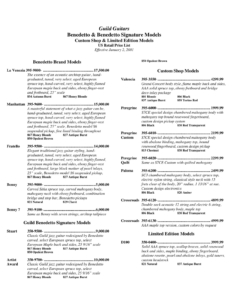 The only price list I have from this range is January 2001 where the Crossroads model 395-6120 is listed for $4,899.99. Listed in only black and transparent red with the AAA maple top version listing for $100 more at $4,999.99 with custom colors by request. This made the Crossroads doubleneck the most expensive guitar in the 2001 price list at $1,000 more than the limited edition D100 acoustic, though that’s only true if we ignore the Guild Benedetto guitars which included the X700 Stuart and the Artist award at $9,000 and $10,000 respectively, though even those are cheap when compared to the Benedetto La Venezia which is in the same price list for a cool $17,500.
The only price list I have from this range is January 2001 where the Crossroads model 395-6120 is listed for $4,899.99. Listed in only black and transparent red with the AAA maple top version listing for $100 more at $4,999.99 with custom colors by request. This made the Crossroads doubleneck the most expensive guitar in the 2001 price list at $1,000 more than the limited edition D100 acoustic, though that’s only true if we ignore the Guild Benedetto guitars which included the X700 Stuart and the Artist award at $9,000 and $10,000 respectively, though even those are cheap when compared to the Benedetto La Venezia which is in the same price list for a cool $17,500.
There are many pictures of Slash playing his many versions of the Guild Crossroads doubleneck Guitar, but this one is one of my favorites. Certainly the transparant green finish on the AAA maple top is glorious, but there are a couple of other things to note. First, the fretboard on the bottom neck appears to be ebony. Second, the top half of the guitar is a six-string acoustic instead of a 12-string! You can see him playing Anastasia with this guitar (or one very much like it) in this YouTube video (and the better one from the introduction) and Neither Can I from his Snake Pit days in this YouTube Video.
Here’s another picture of Slash, this time with a red 12/6 Crossroads doubleneck just like the one in this review, though it doesn’t look like this one has the AAA top, so there’s proof right there that my guitar is nicer than Slash’s. Probably. Well, not after looking at the picture of that green one again. Damn.
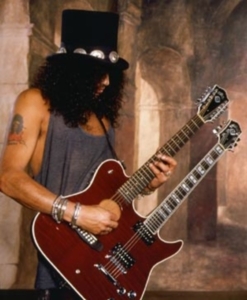 A quick note about fakes is in order. If you decide that you want one of these uncommon and expensive guitars, do your homework because there are a lot of (mostly) Chinese fakes out there. I’ve also seen a number of people making their own excellent copies which I can’t blame anyone for after paying what I did for mine, but just be careful because there are a far number of variations so authenticating the real thing can be a challenge.
A quick note about fakes is in order. If you decide that you want one of these uncommon and expensive guitars, do your homework because there are a lot of (mostly) Chinese fakes out there. I’ve also seen a number of people making their own excellent copies which I can’t blame anyone for after paying what I did for mine, but just be careful because there are a far number of variations so authenticating the real thing can be a challenge.
On the topic of authenticating these rare guitars, when I bought mine I was concerned that the label inside the sound hole was printed, while I’ve seen many others where the label was hand-written. After asking Hans Moust, author of The Guild Guitar Book, who assured me that both were valid, I went ahead and bought the one in my possession.
The case
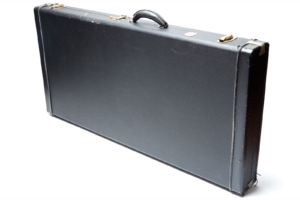 The case for the Guild Crossroads doubleneck guitar is enormous. This is a large guitar so it makes sense that it would come in a large case, but the case is also fairly thin which means it’s a bit wobbly when sitting on the edge like it is in this first photo. If you have a cat, an open window or even a freaking ceiling fan, I would not recommend leaving the case in this position for long, at least not freestanding.
The case for the Guild Crossroads doubleneck guitar is enormous. This is a large guitar so it makes sense that it would come in a large case, but the case is also fairly thin which means it’s a bit wobbly when sitting on the edge like it is in this first photo. If you have a cat, an open window or even a freaking ceiling fan, I would not recommend leaving the case in this position for long, at least not freestanding.
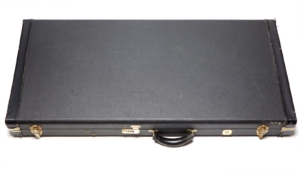 After laying the case down on its side and taking a deep breath of relaxation, you start to really understand just how large the case is. Thankfully the case is reasonably well made and comes with a heavy-duty handle which is a good thing since the guitar is heavy enough without the case, so it’s pretty unwieldy in this giant case that acts like a sail in anything other than the calmest of days.
After laying the case down on its side and taking a deep breath of relaxation, you start to really understand just how large the case is. Thankfully the case is reasonably well made and comes with a heavy-duty handle which is a good thing since the guitar is heavy enough without the case, so it’s pretty unwieldy in this giant case that acts like a sail in anything other than the calmest of days.
With the case open you can marvel at the green lining which is found on every Guild Custom Shop guitar from this era that I’ve ever seen. Something that I’ve not seen, however, is the fading that is very present in this case, and from what I can tell, is present in a large number of the Crossroads doublenecks out there as well. I’m not sure why this happens, but it seems common enough that I think it’s a manufacturing flaw of some kind.
The proper case for this guitar should have a Guild Custom Shop badge on it like the one shown here. I’ve seen these big guitars for sale in gig bags, and all I can say is that I would not buy one of these without the original case unless it was significantly marked down at which point I’d probably worry that it was a fake.
Since the guitar is so uniquely shaped, it’s difficult to hang on the wall and difficult to rest on a stand so I’d imagine all of them spending their down time in the case, but then I’ve seen bands do some pretty strange things on stage with their instruments.
One more photo is in order, this time showing the big doubleneck case standing behind one of my Guild Nightbird cases. I can’t say enough about how much the doubleneck case doesn’t fit anywhere. It sticks out lined up against other cases on its side, it sticks up when sitting against other cases on its long side, and it’s generally just a pain in the ass to have in a room, car, or anything smaller than a van.
But it’s cool, so it stays.
Finish
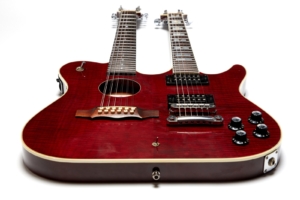 The 2002 Guild section that is part of the Fender Frontline catalog for that year is one of the few catalog that specifically indicates the finish type used on different guitars, and in that catalog the Crossroads doubleneck is listed as having a Nitrocellulose Lacquer finish. Shining a UV light on the guitar makes the entire thing fluoresce in the sickening green of a nice aged nitro finish, so I have no reason to doubt the catalog.
The 2002 Guild section that is part of the Fender Frontline catalog for that year is one of the few catalog that specifically indicates the finish type used on different guitars, and in that catalog the Crossroads doubleneck is listed as having a Nitrocellulose Lacquer finish. Shining a UV light on the guitar makes the entire thing fluoresce in the sickening green of a nice aged nitro finish, so I have no reason to doubt the catalog.
The red finish on this guitar is very dark, so if you were getting ready to complain that my pictures don’t do the guitar justice, I’m here to tell you that they’re pretty accurate, at least for this particular guitar.
Fretboards and Necks
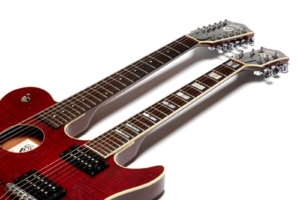 There’s more to a doubleneck guitar than the fact that it has two necks. I mean, it’s not just a guitar with two necks – it’s two guitars fused or built as one. Still, they’re not called double-guitars, they’re called doublenecks, so let’s talk about those necks.
There’s more to a doubleneck guitar than the fact that it has two necks. I mean, it’s not just a guitar with two necks – it’s two guitars fused or built as one. Still, they’re not called double-guitars, they’re called doublenecks, so let’s talk about those necks.
Both of the necks on the Crossroads doubleneck have a scale length of 24 ¾”, but aside from that they are really quite different. I think the guitar is a bit oddly balanced visually with the high-end bound rosewood fretboard with v-block inlays on the electric side and low-end unbound rosewood fretboard with dot inlays on the 12-string side. The oddity of that is reinforced for me as a Guild fan because V-Block inlays really only appear on high-end Guilds while plain unbound fretboards with dot inlays really only appear on lower-end Guilds. I’m going to have to go with “Slash liked it that way” and stop thinking about it, but it’s also possible that more inlays would have made the guitar even more expensive and were forgone in order to meet a price point.
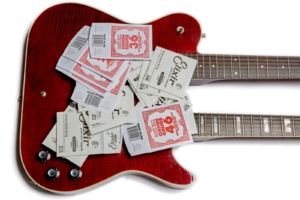 On a related note, if you hate changing the strings on your guitar, do not buy a doubleneck. Holy crap what a pain in the ass. First, there is the simple math involved that indicates that there are 18 strings to be replaced, six with full-sized tuners, and 12 with mini-tuners. That’s 18 strings to be cut, coiled and discarded (or recycled), 18 strings to unpack, and 18 string packages to discard.
On a related note, if you hate changing the strings on your guitar, do not buy a doubleneck. Holy crap what a pain in the ass. First, there is the simple math involved that indicates that there are 18 strings to be replaced, six with full-sized tuners, and 12 with mini-tuners. That’s 18 strings to be cut, coiled and discarded (or recycled), 18 strings to unpack, and 18 string packages to discard.
But that’s not the worst of it.
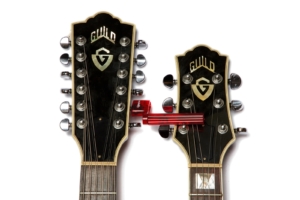 Because the necks are right next to each other, you can’t use any kind of string winder on the inside tuners! Not manual, not powered, and certainly not one of those big Planet Waves numbers with the built in string cutters. Not only that, but you can’t easily grip any of those inside tuners so you have to tune all nine of those strings with your fingertips. And yes, it sucks tuning those inside strings on the fly between songs, too. This is one of those things that never occurred to me until I had the guitar in my hands, but it seems to me that this would be a problem for all doublenecks.
Because the necks are right next to each other, you can’t use any kind of string winder on the inside tuners! Not manual, not powered, and certainly not one of those big Planet Waves numbers with the built in string cutters. Not only that, but you can’t easily grip any of those inside tuners so you have to tune all nine of those strings with your fingertips. And yes, it sucks tuning those inside strings on the fly between songs, too. This is one of those things that never occurred to me until I had the guitar in my hands, but it seems to me that this would be a problem for all doublenecks.
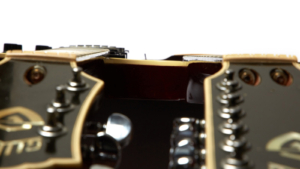 One of the stranger aspects of this guitar is that the angles are different on the two necks. That really threw me at first and I was convinced that the 12-string side needed a neck reset, but after measuring with a straightedge I determined that both necks are actually perfectly inline with their respective bridges. Why is this the case? In the words of renound Guild expert Hans Moust, “I would not be surprised if the angle on the 12-string would be a little less severe, since the bridge height of the 12-string can be a little lower than the tune-o-matic style bridge on the 6-string“, which is exactly what’s going on as you can see in this photo.
One of the stranger aspects of this guitar is that the angles are different on the two necks. That really threw me at first and I was convinced that the 12-string side needed a neck reset, but after measuring with a straightedge I determined that both necks are actually perfectly inline with their respective bridges. Why is this the case? In the words of renound Guild expert Hans Moust, “I would not be surprised if the angle on the 12-string would be a little less severe, since the bridge height of the 12-string can be a little lower than the tune-o-matic style bridge on the 6-string“, which is exactly what’s going on as you can see in this photo.
Both of the necks on the Crossroads Doubleneck are pretty large, with the 6-string neck measuring 1 ¾” at the nut and the 12-string neck measuring just a bit more than that at 1 13/16″. The 6-string neck is solid mahogany like you might find on a Bluesbird (since that’s what it is), and the 12-string neck is a 3-piece ‘hog/maple/’hog like you might find on a vintage Guild D212 or F212 12-string. The fretboard radius appears to be 12″ on both necks and the frets are .05″ x .105″ on both as well.
Build Quality
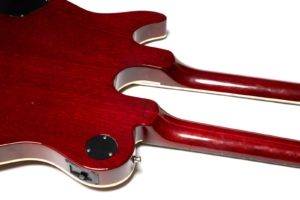 According to the catalogs the beautiful top is a laminate, and my investigations confirm this. The maple top is .15″ thick on the 12-string side (measured at the sound hole) and appears to be very thin even on the electric 6-string side as well. This makes the construction of the electric guitar side quite different than a Les Paul or a later Guild Bluesbird that has a carved maple top of considerable thickness. Still, it looks sexy as hell and a thick carved top would add even more weight to an already heavy guitar.
According to the catalogs the beautiful top is a laminate, and my investigations confirm this. The maple top is .15″ thick on the 12-string side (measured at the sound hole) and appears to be very thin even on the electric 6-string side as well. This makes the construction of the electric guitar side quite different than a Les Paul or a later Guild Bluesbird that has a carved maple top of considerable thickness. Still, it looks sexy as hell and a thick carved top would add even more weight to an already heavy guitar.
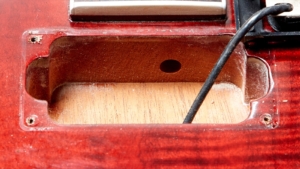 How heavy? This example weighs in at a cool 11lbs 11oz (5.3 kg) which, let’s be honest here, is damn near 12 pounds. That’s still not as heavy as the heaviest Les Paul I ever played (a 13 pound Norlin monster), but the weight is spread out over a larger area on the Crossroads Doubleneck, so I dare say it doesn’t feel all that bad. I wouldn’t want to play a three-hour gig with one hanging from a 2″ strap, but it’s definitely tolerable for a song or two.
How heavy? This example weighs in at a cool 11lbs 11oz (5.3 kg) which, let’s be honest here, is damn near 12 pounds. That’s still not as heavy as the heaviest Les Paul I ever played (a 13 pound Norlin monster), but the weight is spread out over a larger area on the Crossroads Doubleneck, so I dare say it doesn’t feel all that bad. I wouldn’t want to play a three-hour gig with one hanging from a 2″ strap, but it’s definitely tolerable for a song or two.
Back to the top, it is indeed a maple laminate so don’t think this guitar is going to sound like your favorite Guild JF65-12 jumbo acoustic guitar, because it’s not. The back and sides of the acoustic side of the instrument are similarly not built like an acoustic guitar, but more like a chambered Bluesbird or Nightbird since it’s a hollowed out piece of mahogany rather than pressed solid or laminated wood like you’d find on an acoustic guitar.
Both of the neck joints are traditional Guild set necks, and the 12-string side did need a tweak of the truss rods (there are two) when I got it due to its cross-country trek in the cold. The body is bound on the front by a very nice 5-layer binding
Delivery Issues
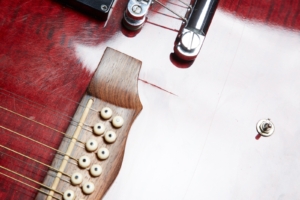 Unfortunately, when I received the guitar I discovered two issues with it, the first being a crack in the top. The crack is right in the middle of the guitar and coincides with the seam between the two sides of the book-matched veneer. I believe this is at least partially due to the stress of the bridge from supporting 12 strings, and given the state of the strings when I got it, I’d venture a guess that the guitar had sat strung to pitch in storage for years.
Unfortunately, when I received the guitar I discovered two issues with it, the first being a crack in the top. The crack is right in the middle of the guitar and coincides with the seam between the two sides of the book-matched veneer. I believe this is at least partially due to the stress of the bridge from supporting 12 strings, and given the state of the strings when I got it, I’d venture a guess that the guitar had sat strung to pitch in storage for years.
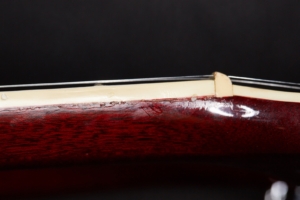 The second problem was that the six-string neck appears to have suffered a partial fretboard separation that was repaired in a way so as to make the repair noticeable. I actually didn’t notice the problem by feeling the side as you might expect from the photo, but from a blob of glue that stuck to the side of the first fret. That’s when I emailed the seller who decided to be unhelpful and refused to work with me.
The second problem was that the six-string neck appears to have suffered a partial fretboard separation that was repaired in a way so as to make the repair noticeable. I actually didn’t notice the problem by feeling the side as you might expect from the photo, but from a blob of glue that stuck to the side of the first fret. That’s when I emailed the seller who decided to be unhelpful and refused to work with me.
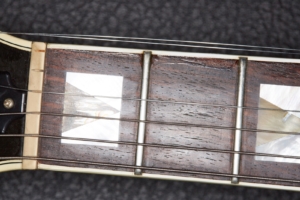 Luckily, Reverb saved the day and refunded part of my purchase price much to the displeasure of the seller. For what I paid for this thing, there should have been no issues, and while I’m fine with issues, disclose them in your ad. Luckily neither of these problems seem to affect playability of the instrument(s) but for the price paid I could have bought two nice Nightbirds and a vintage D212, so you’re damn right I pursued recompense.
Luckily, Reverb saved the day and refunded part of my purchase price much to the displeasure of the seller. For what I paid for this thing, there should have been no issues, and while I’m fine with issues, disclose them in your ad. Luckily neither of these problems seem to affect playability of the instrument(s) but for the price paid I could have bought two nice Nightbirds and a vintage D212, so you’re damn right I pursued recompense.
None of these issues are quality or build issues, but I like to be thorough when I describe my guitars if that’s not painfully obvious already.
Pickups
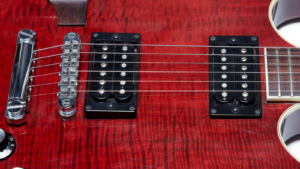 Since this is really two guitars sort of fused (from a design aspect) into one, let’s examine each of the pickup systems separately.
Since this is really two guitars sort of fused (from a design aspect) into one, let’s examine each of the pickup systems separately.
6-String
The pickups on the six-string side are Seymour Duncan (SD) Alnico II Pro HBs, model number APH1B (Bridge) and APH1NL (Neck). I need to point out some things about these pickups that may not be immediately obvious. First, currently (2021) Seymour Duncan is offering APH1s and APH2s. The APH2s were redesigned because Slash’s new signature Les Paul guitars apparently didn’t sound right with the APH1s.
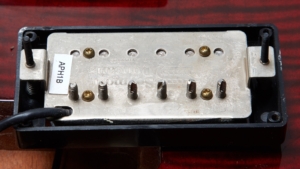 The APH1s, according to Seymour Duncan are the same pickups that Slash used in the original Appetite for Destruction guitar, and when it comes to famous tones, it’s hard to argue with the album that unseated the original Boston album as the #1 debut album of all time.
The APH1s, according to Seymour Duncan are the same pickups that Slash used in the original Appetite for Destruction guitar, and when it comes to famous tones, it’s hard to argue with the album that unseated the original Boston album as the #1 debut album of all time.
Thankfully the pickups were designed and built before SD decided to obnoxiously paste their name all over the front of the bobbins of new pickups, a decision that has made me swap out the pickups on many guitars that had them, and yes, I detest logos on pickups. Hey Seymour Duncan – if you would like to pay me to be a sponsor so that I’ll play and review pickups with your names on them, drop me a line so I can say, “no”.
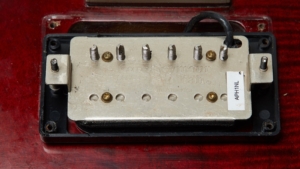 These pickups are right up my alley because they’re both low-wind and very PAFish. I’m a big fan of Alnico II magnets in humbuckers and P90s, and these deliver the goods with that great Alnico II growl that I like so much.
These pickups are right up my alley because they’re both low-wind and very PAFish. I’m a big fan of Alnico II magnets in humbuckers and P90s, and these deliver the goods with that great Alnico II growl that I like so much.
It’s pretty common for me to swap out pickups in my guitars for something with more character, but since these sound great and don’t have obnoxious branding on them, they’ll stay in the guitar. Also, I guess they’re good enough for Slash, so they can’t be all bad.
12-String
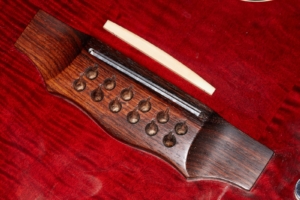 According to the 1997-1998 Guild Gallery magazine, the 12-string side incorporates a Fishman transducer-equipped bridge. From a semantic point of view, I’d probably write that as a bridge equipped with a Fishman transducer because the catalog copy makes it seem as though the bridge is made by Fishman which I don’t think is the case.
According to the 1997-1998 Guild Gallery magazine, the 12-string side incorporates a Fishman transducer-equipped bridge. From a semantic point of view, I’d probably write that as a bridge equipped with a Fishman transducer because the catalog copy makes it seem as though the bridge is made by Fishman which I don’t think is the case.
The piezo transducer is easily seen by removing the saddle from the 12-string bridge which, along with the volume control on the upper bout, are the only indications that the 12-string has a pickup system. That’s just the pickup, though; the electronics are a whole different topic.
Electronics
The controls on this guitar are fairly intuitive. The four main G-shield knobs behave like they would on any two-pickup electric guitar, and the pickup selector selects the pickups, though it’s all the way on the top bout on the 12-string half. There is a single control for the acoustic guitar which is a volume on the top side of the body, and the two guitars are selected with a mini toggle switch that sits right in the middle of the two guitars down near the bottom strap peg.
Tracing the wiring for these controls was less than intuitive, though.
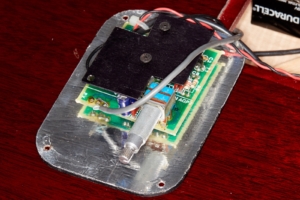 I was intrigued when I found that the internal preamp had a functioning potentiometer on it. Though that’s not unusual, most hidden preamps that I’ve encountered have had little trimpots for gain and not full knob-worthy pots. But that’s not all, since the pot that’s only accessible when you remove the cover is a stacked pot with middle detents which means it’s actually two controls. It was at this point that I decided to see if I could find any more information about this preamp.
I was intrigued when I found that the internal preamp had a functioning potentiometer on it. Though that’s not unusual, most hidden preamps that I’ve encountered have had little trimpots for gain and not full knob-worthy pots. But that’s not all, since the pot that’s only accessible when you remove the cover is a stacked pot with middle detents which means it’s actually two controls. It was at this point that I decided to see if I could find any more information about this preamp.
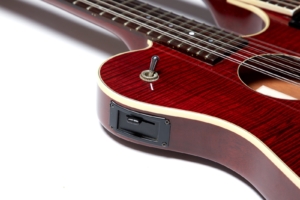 The preamp is a Fishman AGP2 Rev2 (manual) which was designed such that two knobs would be visible and available on the side of an acoustic guitar. On this guitar, the volume pot has been removed and replaced with the slider that’s visible on the upper bout while the notched treble and bass rolloff controls remain hidden under the cover. While I supposed that could make sense if space were a concern, it looks to me like the volume slider has plenty of room for another control and that the tone control was deliberately hidden. Perhaps this is a Slash design influence.
The preamp is a Fishman AGP2 Rev2 (manual) which was designed such that two knobs would be visible and available on the side of an acoustic guitar. On this guitar, the volume pot has been removed and replaced with the slider that’s visible on the upper bout while the notched treble and bass rolloff controls remain hidden under the cover. While I supposed that could make sense if space were a concern, it looks to me like the volume slider has plenty of room for another control and that the tone control was deliberately hidden. Perhaps this is a Slash design influence.
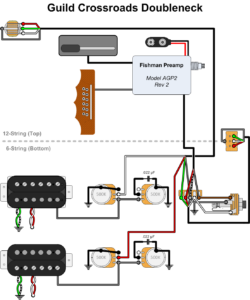 In the picture of the acoustic volume slider you can also see what I consider to be one of the odder design choices on the guitar, which is the fact that the pickup selector for the 6-string electric part of the guitar is on the upper bout on the 12-string acoustic side of the guitar. Then again it makes sense given the lack of space in-between the two guitar halves and the available space on the upper bout where it is. Plus it looks right from a Les Paul design standpoint which is the guitar that Slash favors.
In the picture of the acoustic volume slider you can also see what I consider to be one of the odder design choices on the guitar, which is the fact that the pickup selector for the 6-string electric part of the guitar is on the upper bout on the 12-string acoustic side of the guitar. Then again it makes sense given the lack of space in-between the two guitar halves and the available space on the upper bout where it is. Plus it looks right from a Les Paul design standpoint which is the guitar that Slash favors.
I can tell you that tracing the wiring for this guitar was a bit of a challenge (which is manager-speak for it sucked), mostly due to the way that the two guitars are wired together onto a 5-position terminal strip that is soldered to the back of the neck pickup tone control.
The terminal strip is the point where the two guitars come together, but that is made a touch more complicated by the facts that 1) the cable sheaths that go to the pickup selector switch, the preamp output, and the guitar selector switch are all black, 2) they all terminate on this strip, and 3) all three cables use green, black, white, and red wires. Oh, and 90% of all of that is hidden within the guitar where you can’t see it! That all meant that tracing each of the cables was a bit of an adventure. Luckily, I used to work in mainframes and remember a time when wire-wrapping was a thing such as on this PDP-8i backplane from WikiPedia.
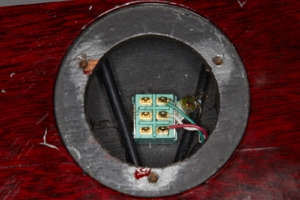 Really, though, the colors are used logically, and though red and white are used for different purposes depending on the cable, at the terminal strip, red is the output signal from the acoustic preamp, green is the output from the electric pickup selector switch, and white is the signal path to the output jack. Black is almost always ground except in the case of the acoustic preamp where the braided cable is ground and the black cable is wired to the third lug on the output jack so that removing the guitar cable can disconnect the battery. With that wiring scheme in mind, looking at the guitar selector mini-toggle makes perfect sense as it switches the output jack (white) between the acoustic (red) and electric (green) guitars.
Really, though, the colors are used logically, and though red and white are used for different purposes depending on the cable, at the terminal strip, red is the output signal from the acoustic preamp, green is the output from the electric pickup selector switch, and white is the signal path to the output jack. Black is almost always ground except in the case of the acoustic preamp where the braided cable is ground and the black cable is wired to the third lug on the output jack so that removing the guitar cable can disconnect the battery. With that wiring scheme in mind, looking at the guitar selector mini-toggle makes perfect sense as it switches the output jack (white) between the acoustic (red) and electric (green) guitars.
The pots are all 500k, though I did not remove any and so could not discern any brand names, and the capacitors are both .022 μF.
If electronics scare you, don’t do your own work on this guitar.
Hardware
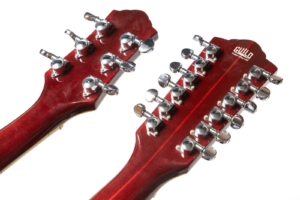 One of the first things that stands out about this guitar is the sheer number of machine heads on the headstocks. That’s 18 total for those who couldn’t figure it out on their own, with six being full-size and 12 being minis. These are all Grover Rotomatics and they all work great, and yes, they add a significant amount of weight to the headstock end of the guitar. How much weight? As detailed as I like to be, there was no way I was going to pull off all those tuners and weigh them, but I can tell you that according to StewMac (the Grover website doesn’t list weights as of December 2020), the 6-string tuners weigh a total of .62 lbs while the 12-string tuners (two sets of 6-in-line) weigh a total of .89 lbs. That’s a total of 1.51 lbs (.69 kg) of tuners weighing down the very end of those two necks.
One of the first things that stands out about this guitar is the sheer number of machine heads on the headstocks. That’s 18 total for those who couldn’t figure it out on their own, with six being full-size and 12 being minis. These are all Grover Rotomatics and they all work great, and yes, they add a significant amount of weight to the headstock end of the guitar. How much weight? As detailed as I like to be, there was no way I was going to pull off all those tuners and weigh them, but I can tell you that according to StewMac (the Grover website doesn’t list weights as of December 2020), the 6-string tuners weigh a total of .62 lbs while the 12-string tuners (two sets of 6-in-line) weigh a total of .89 lbs. That’s a total of 1.51 lbs (.69 kg) of tuners weighing down the very end of those two necks.
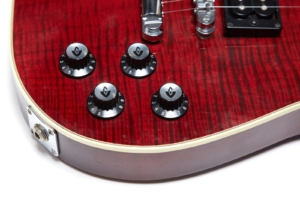 The knobs are black G-Shield knobs from the late Westerly era, though I’ve seen examples online of this model with different knobs along with the example in the catalog shown in the introduction, likely due to either the year it was made and/or the finish used.
The knobs are black G-Shield knobs from the late Westerly era, though I’ve seen examples online of this model with different knobs along with the example in the catalog shown in the introduction, likely due to either the year it was made and/or the finish used.
The strap pegs on mine are Fender strap locks, and while I can’t say with certainty if they are original, there is no way I would gig this guitar without some kind of strap locks and a nice wide comfy strap to go with them. At four ounces shy of 12 pounds, this is a guitar that you don’t want to drop on your foot, though for the price you’re likely to pay for one of these guitars you’d probably be glad that your foot broke the fall.
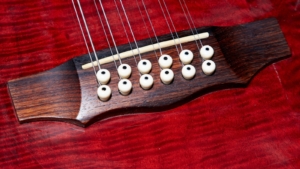 The bridge on the 12-string side looks like rosewood and has the classy Guild curves found on acoustic guitars. There is nothing terribly special about the bridge that I could discern aside from the fact that it is drilled to accept the cable for the under-saddle piezo pickup. The string pegs on the acoustic side are simple plastic with black dots on them.
The bridge on the 12-string side looks like rosewood and has the classy Guild curves found on acoustic guitars. There is nothing terribly special about the bridge that I could discern aside from the fact that it is drilled to accept the cable for the under-saddle piezo pickup. The string pegs on the acoustic side are simple plastic with black dots on them.
There is no pick guard on this guitar which is nice as it shows off the flamed top, but that beautiful top is covered in scuffs as a result. You can’t see them from any appreciable distance, so that’s nice.
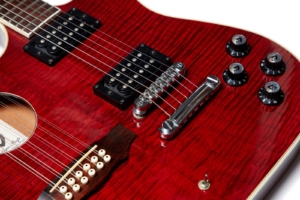 On the six-string side, the bridge and tailpiece are both made by Gotoh which were pretty much standard equipment on almost all Guild electric guitars from the time when this guitar was made.
On the six-string side, the bridge and tailpiece are both made by Gotoh which were pretty much standard equipment on almost all Guild electric guitars from the time when this guitar was made.
The pickup selector switch is a normal 3-way toggle switch and the guitar selector is a mini-toggle. Part of me feels like that should be a larger switch, but then a mini-toggle makes it both harder to hit by accident while also being harder to move should it be hit by mistake.
Sound
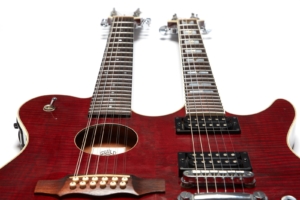 Recording this guitar was an interesting experience because in addition to one of the guitars being a 12-string, it’s also an actual acoustic with a Piezo pickup. I considered recording the acoustic side with one of my Guild acoustic amps, but decided to just use the same clean(ish) amp for my electric reviews because this is likely how I would use it on stage. While Slash probably has someone off-stage switching amps when he goes from acoustic to electric, I would just utilize what’s available to me in my Axe-FX.
Recording this guitar was an interesting experience because in addition to one of the guitars being a 12-string, it’s also an actual acoustic with a Piezo pickup. I considered recording the acoustic side with one of my Guild acoustic amps, but decided to just use the same clean(ish) amp for my electric reviews because this is likely how I would use it on stage. While Slash probably has someone off-stage switching amps when he goes from acoustic to electric, I would just utilize what’s available to me in my Axe-FX.
Also I was feeling particularly lazy when recording this guitar and there’s enough to do with double the recordings without making new patches.
Note that since I keep my 12-strings tuned down a half-step, I also tuned the 6-string down similarly so that the recordings would be in tune with each other.
[dropshadowbox align=”right” effect=”raised” width=”” height=”” background_color=”#ffffff” border_width=”1″ border_color=”#dddddd” ]ODS100 (6)
Open Chords #1
Open Chords #2
D-shape
7th
JCM-800 (6)
A Shape
D Shape
[/dropshadowbox]In the past, when playing acoustic live, I made a cut-through patch on my Axe-FX so that I was basically just using my Full-Range Flat Response (FRFR) speaker’s amp to make the guitar louder. Since this guitar is so thin and doesn’t sound like a big acoustic guitar, I decided to just use the ODS100 patch which is a simulation of the coveted Dumble Overdrive Special.
As usual, for these recordings I used my normal Axe-FX III through the QSC K12 speaker recorded direct into my Mac Pro using Audacity. I recorded using the ODS100 Clean patch, as well as the JCM-800 and as stated above, used the same OSD100 patch for the 12-string side of the guitar. For each of the 6-string recordings I cycle through the neck pickup, both pickups, and finally the bridge pickup. All knobs on the guitar are on 10 at all times.
To be totally fair, I bet I could dial in a better acoustic sound through better amp choices and/or effects, but the fact remains that this is anything but a big-bodied Guild jumbo, so don’t expect it to sound like one. This guitar is very cool but it is a compromise that lets you get the job done without having to grab another guitar.
The 6-string side doesn’t really have the ring and sustain of a nice Bluesbird or Nightbird, but it’s no slouch, either. The pickups are wonderful as expected, and deliver all the tones I’d expect from a mahogany solid-body guitar with Seymour Duncan Alnico II Pro humbuckers.
One of the things that surprised me when playing was the fact that there’s a cool sympathetic echo from the 12-string side when playing the 6-string that adds a liveliness to the guitar that’s really addictive and hard to explain if you’re not actually playing the guitar.
[dropshadowbox align=”right” effect=”raised” width=”” height=”” background_color=”#ffffff” border_width=”1″ border_color=”#dddddd” ]ODS100 (12)
Open Chords #1
Open Chords #2
Open 7th Chords
D-Shape
Hotel California
[/dropshadowbox]On the 12-string side of the guitar, things are a little bit different because it’s not an electric guitar and it’s a big deep booming Guild 12-string. Unplugged, the 12-string side can sound a bit like a Ukulele because of the thin body, especially when a capo is used.
Speaking of capos, this guitar is a pain in the ass to use with a capo, but that’s a problem common to 12-string guitars. To alleviate this, I placed a rubber band under the rubber edge of my capo so that pressure is applied to both the low and high-octave strings on the bottom four pairs. This works remarkably well for recording but is a practical impossibility when performing on stage where a quick-change may be required. Certainly there are 12-string capos out there for exactly this reason, but I simply did not have one.
While my capo trick did work well, the guitar still needed to be tuned a bit with the capo in place, but I can’t really blame the guitar for that. For the Hotel California recording, the capo is on the 7th fret which is a bit of a torture test for this guitar.
Playability
Standing with a strap, I quickly discovered that the guitar is very neck heavy, and with a deluxe slippery leather strap seemed to be almost unplayable because I had to spend too much energy making sure I was not letting the neck fall. This is due to the fact that the strap pegs are both on the body and that there is what feels like 15 pounds of tuners on the end of those two necks. The center of gravity is right at about the neck heels on the guitar, and that’s inside the space between the two strap pegs. Because of this arrangement the necks feels like it’s heavier than the body when hanging on a strap. If it were possible to move the top strap peg to about the 15th fret, I think the neck diving would cease. Obviously that’s not a viable option, so we have an expensive heavy guitar that wants to slam its headstocks into the ground. I have to wonder if this problem is less prevalent on the six/six-string models since there’s less headstock, fewer strings, and fewer machine heads weighing down the necks.
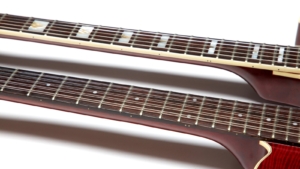 Weight distribution aside, I found myself trying to figure out which neck to make comfortable. If you adjust the strap so that the sweet spot is in the middle of the two necks, then neither one is comfortable since you’re splitting the difference between them. For me, I think making the bottom neck playable had priority because it’s easier to play a neck that’s too high than one that’s too low and with the bottom one just right or maybe just a touch lower than I like, then the top neck is playable if a bit high. It doesn’t look nearly as cool, though. Also, the intonation on the 12-string is not great, so if you’ll be using a capo expect to be tuning for it.
Weight distribution aside, I found myself trying to figure out which neck to make comfortable. If you adjust the strap so that the sweet spot is in the middle of the two necks, then neither one is comfortable since you’re splitting the difference between them. For me, I think making the bottom neck playable had priority because it’s easier to play a neck that’s too high than one that’s too low and with the bottom one just right or maybe just a touch lower than I like, then the top neck is playable if a bit high. It doesn’t look nearly as cool, though. Also, the intonation on the 12-string is not great, so if you’ll be using a capo expect to be tuning for it.
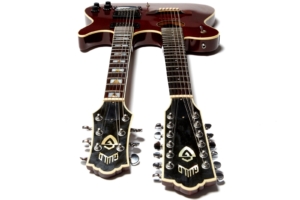 Sitting, the guitar is surprisingly playable on both necks, which kind of makes sense because a sitting position equates to what I described above with the bottom neck being playable. What I didn’t count on is the bruising that occurred from having such a high body jammed into my armpit and chest. To be fair I’m also a pasty white Irish guy who rarely goes outside, but I’ve never had that happen with other guitars so I’m blaming the Guild.
Sitting, the guitar is surprisingly playable on both necks, which kind of makes sense because a sitting position equates to what I described above with the bottom neck being playable. What I didn’t count on is the bruising that occurred from having such a high body jammed into my armpit and chest. To be fair I’m also a pasty white Irish guy who rarely goes outside, but I’ve never had that happen with other guitars so I’m blaming the Guild.
Conclusion
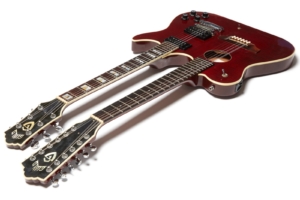 Let’s get to the bottom line here: Would I recommend this guitar?
Let’s get to the bottom line here: Would I recommend this guitar?
That question is really answered by another question: Do you really need a doubleneck guitar? And if so, so you want the 12-string side to have a more acoustic sound than say, a Gibson EDS-175 like the one Jimmy Page used? If so, then yes I would recommend this guitar. In fact you’d be hard pressed to find another guitar that does precisely that as well as the Guild Crossroads doubleneck.
Should you buy one because you’ve always wanted to try a doubleneck guitar? I’d have to say probably not. First off, these guitars rarely come up for sale and when they do they are usually ludicrously expensive. They’re not really practical unless you have the problem that they were built to solve, they’re heavy, they’re not well balanced and as I’ve written, they’re expensive. If you want to try a doubleneck see if you can find an Epiphone to try out before you hunt one of these down. Of course, you could always buy the current Gibson Slash ’66 reissue that has a street price of over $13,000, but then you wouldn’t get the fine acoustic quality of the Guild 12-string. Sure, it doesn’t sound quite like a fine Guild 12-string acoustic, but it looks very cool!
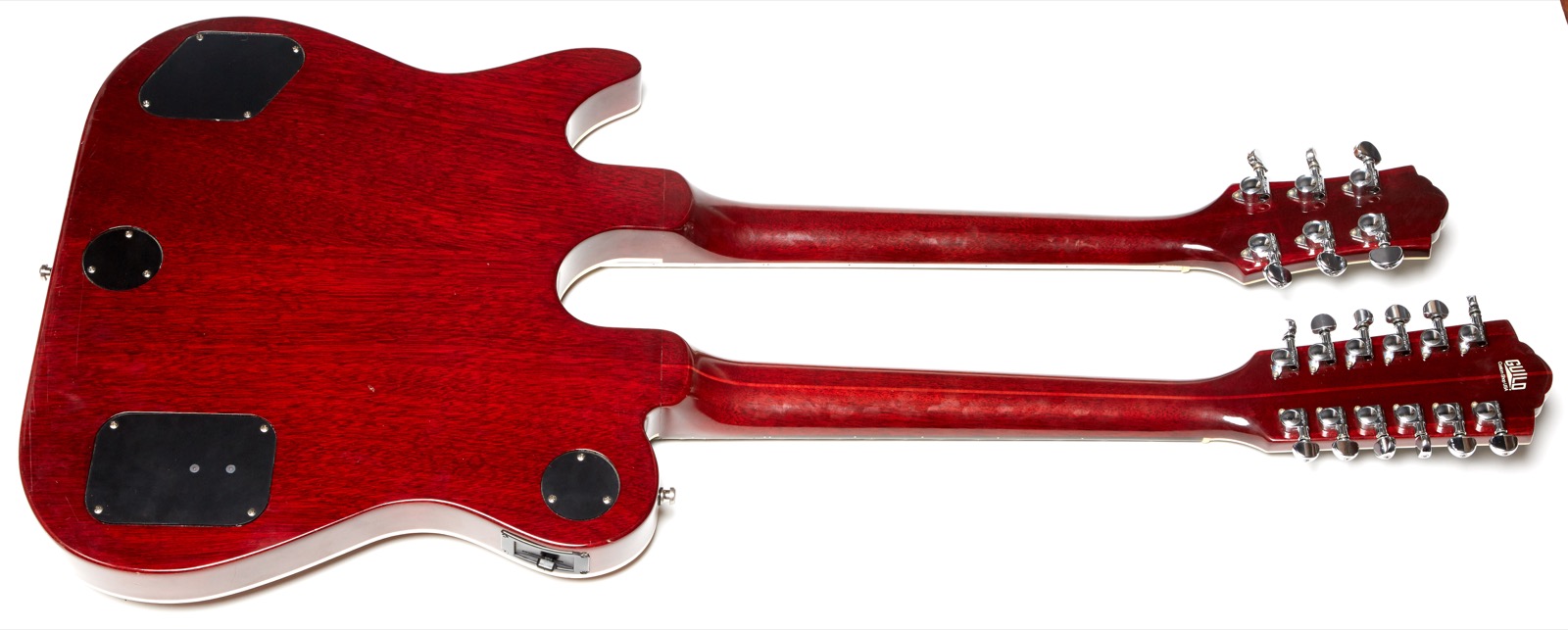
Do I regret buying this monster? Not in the least. Why not? Because I’m an idiot collector of rare Guilds with more money than brains that had a Crossroads doubleneck sized hole in his collection. If that describes you or, you know, you have a legitimate need for such a specific instrument, then jump in because this guitar will absolutely make you feel like a god on stage, even if that stage is in your basement.
Donate: PayPal Crypto:
ETH: 0x0AC57f8e0A49dc06Ed4f7926d169342ec4FCd461
Doge: DFWpLqMr6QF67t4wRzvTtNd8UDwjGTQBGs

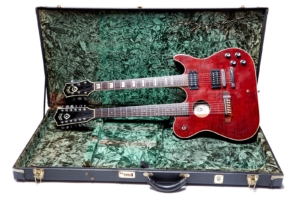
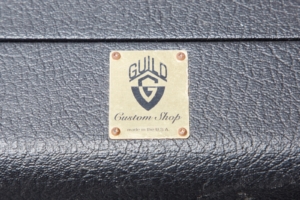
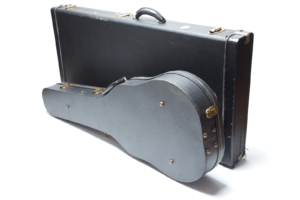

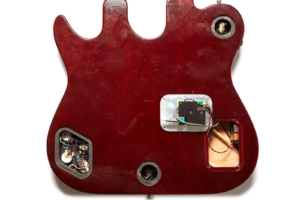
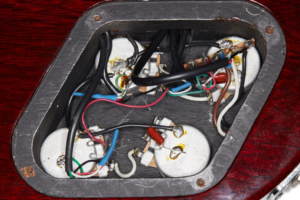
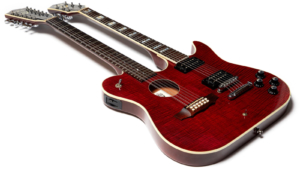
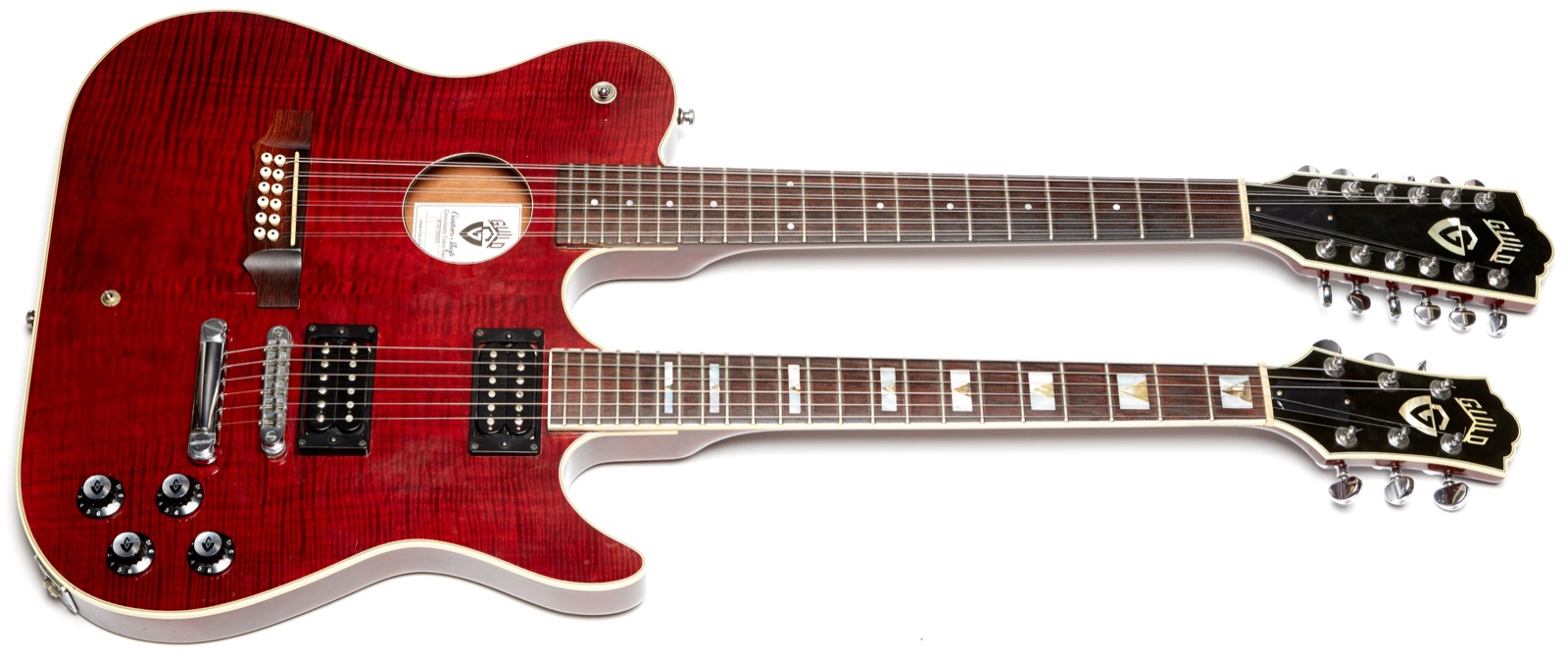
Awesome review. What is the body width at the widest point (lower bout)?
Thanks